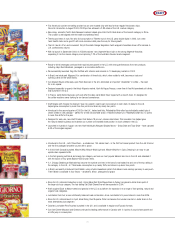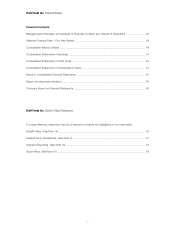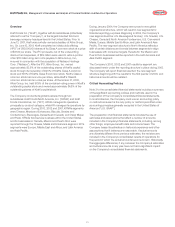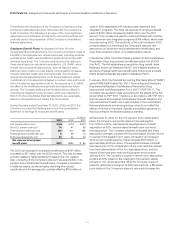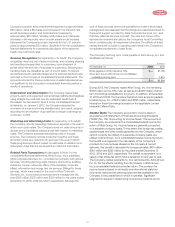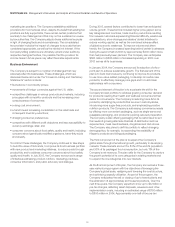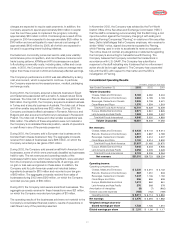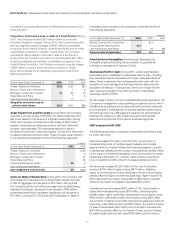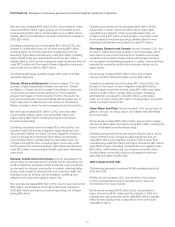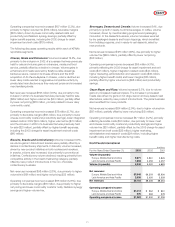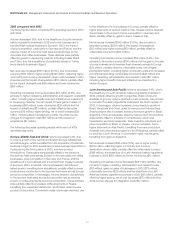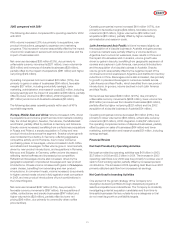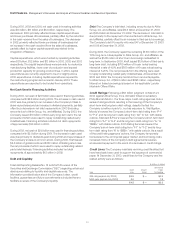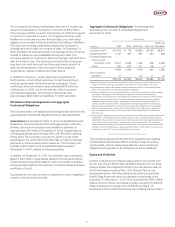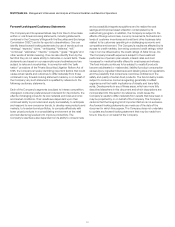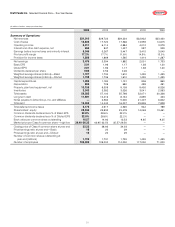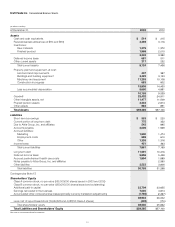Kraft 2003 Annual Report Download - page 32
Download and view the complete annual report
Please find page 32 of the 2003 Kraft annual report below. You can navigate through the pages in the report by either clicking on the pages listed below, or by using the keyword search tool below to find specific information within the annual report.
Kraft Foods Inc. Management’s Discussion and Analysis of Financial Condition and Results of Operations
Net revenues increased $422 million (2.0%), due primarily to higher
volume/mix ($170 million), higher pricing, net of increased promo-
tional spending ($151 million), and favorable currency ($120 million),
partially offset by the divestiture of a small confectionery business in
2002 ($21 million).
Operating companies income decreased $33 million (0.7%), due
primarily to unfavorable costs, net of higher pricing ($161 million,
including higher commodity costs and increased promotional
spending), higher fixed manufacturing costs ($79 million, including
higher benefit costs) and unfavorable volume/mix ($37 million),
partially offset by 2002 pre-tax charges for asset impairment and exit
costs ($135 million) and the impact of lower integration costs and a
loss on sale of a food factory ($107 million).
The following discusses operating results within each of KFNA’s
reportable segments.
Cheese, Meals and Enhancers: Volume increased 1.7%, due
primarily to higher shipments in cheese, food service, Canada
and Mexico. Cheese volume increased due primarily to improved
consumption and share trends resulting from the investment
program that began in the third quarter of 2003. Volume for the
food service business in the United States also increased, due to
higher shipments to national accounts. Volume in Canada and
Mexico increased, driven by new beverage product introductions.
Net revenues increased $267 million (2.9%), due to favorable
currency ($120 million), higher volume/mix ($82 million) and
higher pricing ($65 million, including the impact of increased
promotional spending).
Operating companies income increased $20 million (0.9%), due
primarily to the 2002 pre-tax charges for asset impairment and
exit costs ($60 million), the impact of lower integration costs and
aloss on the sale of a food factory ($40 million) and favorable
currency ($22 million), partially offset by unfavorable costs, net
of higher pricing ($72 million, including higher commodity costs
and increased promotional spending), higher fixed manufacturing
costs ($23 million, including higher benefit costs) and unfavorable
volume/mix.
Biscuits, Snacks and Confectionery: Volume decreased 4.7%,
due primarily to lower shipments in biscuits and the divestiture of a
small confectionery business in 2002. In biscuits, volume declined,
due primarily to reduced consumption in cookies, reflecting higher
pricing, lower impact of new products, and consumer health and
wellness concerns. Snacks volume increased, benefiting from
category and consumption gains in snack nuts.
Net revenues decreased $86 million (1.8%), due to lower volume/mix
($56 million), the divestiture of a small confectionery business in
2002 ($21 million) and higher promotional spending, net of higher
pricing ($9 million).
Operating companies income decreased $164 million (15.6%),
due primarily to lower volume/mix ($84 million), higher fixed
manufacturing costs ($77 million) and unfavorable costs, net
of higher pricing ($71 million, including higher commodity costs
and increased promotional spending), partially offset by lower
marketing, administration and research costs ($77 million).
Beverages, Desserts and Cereals: Volume increased 5.3%, due
primarily to higher shipments of ready-to-drink beverages, which
were aided by new product introductions. Desserts volume also
increased, due primarily to higher shipments of sugar-free items
and increased merchandising programs. In coffee, volume declined,
impacted by competitive activity and a category decline due to
higher prices.
Net revenues increased $155 million (3.5%), due to higher
volume/mix ($100 million) and higher pricing ($55 million).
Operating companies income increased $111 million (9.8%), due
primarily to the impact of lower integration costs ($59 million),
the 2002 asset impairment and exit costs ($47 million) and higher
volume/mix ($43 million), partially offset by higher marketing,
administration and research costs ($31 million), unfavorable
costs, net of higher pricing ($13 million, including higher commodity
costs) and higher benefit costs.
Oscar Mayer and Pizza: Volume increased 1.0%, due primarily to
gains in cold cuts, hot dogs, bacon, soy-based meat alternatives
and frozen pizza.
Net revenues increased $86 million (2.9%), due primarily to higher
volume/mix ($44 million) and higher pricing ($40 million, including the
impact of increased promotional spending).
Operating companies income was equal to the prior year’s, as the
impact of 2002 pre-tax charges for asset impairment and exit
costs ($25 million) and integration costs ($7 million), lower fixed
manufacturing costs ($14 million) and higher volume/mix ($10 million)
was offset by higher marketing, administration and research costs
($51 million), unfavorable costs, net of higher pricing ($5 million,
including higher commodity costs and increased promotional
spending) and higher benefit costs.
2002 compared with 2001
The following discussion compares KFNA’s operating results for
2002 with 2001.
KFNA’s volume increased 8.2%, due primarily to the inclusion
in 2002 of a business that was previously held for sale and
contributions from new products.
Net revenues increased $515 million (2.5%), due primarily to
higher volume/mix ($437 million) and the inclusion in 2002 of a
business that was previously held for sale ($252 million), partially
offset by lower selling prices in response to lower commodity
costs ($154 million).
30



